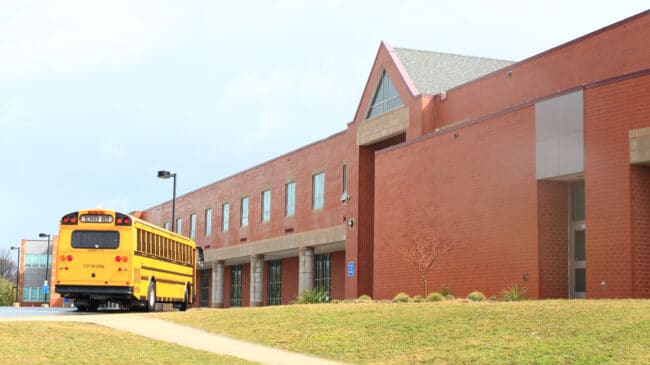Public school enrollment is falling fast, a trend that is likely to persist into the next decade. Between 2019-2020 and 2022-2023, public schools lost 1.2 million students, and the National Center for Education Statistics projects enrollment will drop by another 2.7 million students by 2031-2032.
With falling birthrates and parents increasingly looking to K-12 alternatives—such as private schools and homeschooling—state and local policymakers will need to adapt to the new enrollment reality. Here are five ways they can address the challenges posed by declining enrollment.
1. Shine a light on empty school buildings
Transparency is a foundational tool for addressing K-12 enrollment declines. While states typically publish enrollment data, this isn’t enough.
Underutilized schools often signal financial problems and can mean that families are dissatisfied with the school’s educational quality. Indiana provides a framework for identifying public school facilities that are vacant or underutilized across the state, a critical step for policymakers.
Passed in 2023, Indiana Senate Bill 391 established reporting requirements for school districts whose enrollment declined by 10% or more in the preceding five years. School districts subject to the law must conduct an annual review to identify buildings eligible for closure under the policy. These findings must be reported to the Indiana Department of Education, including an accounting of designed occupancy rates and usage information (e.g., classroom instruction, office space, storage, or special-use classrooms).
While some states make similar information available—typically requiring school districts to publish lists of vacant facilities— they generally fall short. For example, Arizona’s vacant space report fails to capture reliable data about underutilized facilities, with most districts reporting none. In comparison, Indiana’s approach ensures that policymakers, taxpayers, and other stakeholders can fully assess whether school districts are operating efficiently using data collected by the state.
2. Strengthen rights for charters and other K-12 providers
School districts are often reluctant to let go of unused space, even when there are motivated buyers or tenants. One reason is that they don’t want to do business with their competition, which is why about 18 states have adopted right of first refusal laws, giving charter schools priority to purchase surplus facilities. For example, school districts in South Carolina must allow charter schools to purchase or lease surplus buildings at or below the market rate before offering them to the public. But school districts can easily get around these laws by not designating buildings as vacant, a limitation that Indiana lawmakers also recently addressed.
For years, Indiana has required school districts to sell or lease surplus facilities to charter schools for just $1—an ambitious policy with little practical effect. However, Indiana’s policy now broadens eligibility to include underutilized buildings, defined as those operating below 50% capacity in the current and prior two school years. While the law makes some exceptions for school districts (e.g., if the building is used for special student populations at 30% capacity or more), it also allows charters to petition the Indiana Department of Education for a final ruling on closure if they can’t reach an agreement for an eligible building within 45 days.
Indiana strengthened its right of first refusal policy by looking beyond vacant facilities and establishing a clear appeals process that the state’s attorney general can enforce. Policymakers in other states could consider extending these rights to non-profit K-12 providers as well.
3. Eliminate funding protections
Many states have hold-harmless provisions that protect school districts against revenue losses. These policies untether the relationship between funding and student needs, especially during periods of declining enrollment.
Hold harmless policies generally take two forms: 16 states have declining enrollment protections that allow school districts to use prior years’ student counts for funding purposes, while 22 states have funding guarantees that ensure school districts get a minimum level of state aid.
While hold-harmless policies have benefits—such as making budgets more predictable or serving as a bargaining chip to get needed reforms across the finish line—they also have substantial drawbacks. For instance, hold harmless polices weaken the incentive for school districts to right-size or innovate in response to enrollment losses and can also strain state budgets. Reason Foundation estimates that in 2021-22, Missouri’s declining enrollment provision cost the state $197 million—nearly 5% of the state’s total formula aid—while two of its funding protections cost the state another $134 million.
State policymakers should assess the cost of hold-harmless policies and whether these education funding dollars could be used better, which is critical when public school enrollment is falling and states can’t afford to spread dollars thin.
4. Shore up teacher retirement systems
Teacher pension plans are underfunded by hundreds of billions of dollars today, a problem that public school enrollment declines will likely exacerbate. States have failed to set aside enough money to cover the pension benefits promised to teachers, resulting in unfunded liabilities (i.e., the difference between the total pension benefits owed to teachers and the dollars available in pension funds). For instance, Texas’ teacher pension plan had an estimated $70.4 billion in unfunded liabilities in 2023, California’s had $85.6 billion, and Ohio’s had $20.2 billion.
As enrollment falls—and the number of public school teachers likely drops—pension contribution rates for teachers and school districts will continue to rise to service pension debt. As a result, pension costs would consume a larger share of teacher paychecks and school district budgets, leaving fewer dollars for things like pay raises, tutoring, or classroom technology.
Policymakers should take steps to reverse this pension “crowd out” by paying down teacher pension debt as fast as possible to avoid high-interest costs and modernizing antiquated assumptions and benefit designs. For example, states should make more realistic assumptions about their plans’ investment returns and future demographic patterns, which is vital in ensuring solvency. Committing to long-term fiscal discipline in pension funding and modernizing retirement design can prevent the problem from worsening and help mitigate unforeseen increases in contributions.
5. Modernize facilities funding and management
School districts should right-size their facilities footprint in the short term to minimize underutilized or vacant buildings. While some might resist selling assets that might be used in the future—and various legal and regulatory barriers exist that may complicate any divestiture—districts shouldn’t hold onto buildings that aren’t operating in a way that advances their educational mission.
But long-term changes are also needed to how districts manage their portfolios of real property assets.
As public school enrollment declines over time, it could become increasingly difficult for districts to pass general obligation bonds that finance facility construction and improvements. This challenge could become greater in states with robust school choice programs such as open enrollment, education savings accounts, and charter schools. As more students attend schools other than their residentially assigned ones, voters might be reluctant to support local funding measures that they don’t directly benefit from.
They might also object to paying for facilities that benefit students who don’t reside within district boundaries (and whose parents don’t pay local taxes to the district). For instance, Arizona’s Queen Queek Unified—where most of its students are out-of-district transfers—has had difficulty getting voters to approve bonds in recent years, which some blame on the state’s open enrollment program.
To overcome these and other challenges, K-12 policymakers should look to public-private partnerships (P3s). The basic idea is that private companies can partner with public agencies to help build or improve facilities through a combination of support, including finance, design, construction, operations, and/or maintenance. A similar approach has been adopted for other public infrastructure assets such as airports, water/wastewater systems, and various social infrastructure facilities like courthouse facilities, hospitals, and university campus development.
P3s offer several advantages, including cost savings, improved project outcomes, timeliness, and risk-sharing between public and private entities. For instance, in 2021, Prince George’s County Public Schools (PGCPS) entered a P3 arrangement to finance, design, build, and maintain six new schools over 30 years. This deal will save the district an estimated $180 million and expedite construction.
Conclusion
With fewer students in public school classrooms, state and local policymakers should pursue policies that right-size public education. While these solutions aren’t always easy, they can build a foundation for a more sustainable education system in the long run, which is better for students, educators, and taxpayers.

